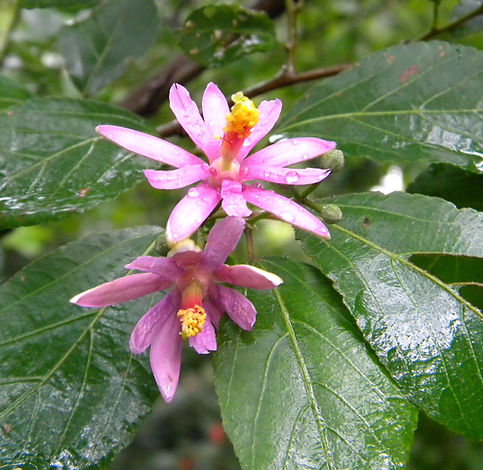

Grewia occidentalis
Water Needs
low; moderate; water wise; drought hardy

Shrub medium; Shrub large; Tree small
Crossberry; Kruisbessie; Assegaaibos IsiXhosa: umNqabaza IsiZulu: iLalanyathi
2 - 6 m
Size
Light Conditions
sun; semi-shade
Frost
hardy
Flowers
Flowers: pink; mauve; purple; summer
Garden Situation
sun; semi-shade; afternoon sun; screen; shrubbery; container; windy exposed; dry soil; sandy soils; small area tree; slope bank; salty; wildlife bees, butterflies insects birds butterfly host
Habitat
hot dry; woodland forest; grassland; rocky places; urban streets; fynbos
Region
Western Cape; thicket; Highveld; subtropical East Coast; Karoo; bushveld savanna; desert
Rain Season
summer; winter
Find informative indigenous gardening articles in our web magazine - www.theindigenousgardener.co.za
Description
The Dune Crossberry is a versatile large shrub or small tree with an extensive distribution range from the coast to inland in the winter and summer rainfall regions that copes with severe frost and hot, dry sun conditions. A Jack-of-all-trades! A favourite choice for wildlife gardeners, it is also an extremely attractive plant with star shaped deep pink to mauve flowers, contrasted with a bright yellow fluffy stamen that stands up above the petals. Flowers attract a variety of pollen feeders and berries bring in an abundance of birds which help to disperse the seeds far and wide. The berries have an unusual shape; four-lobes, initially black, becoming a reddish-brown to light purple when ripe. If not snapped up by birds, they can remain on the tree for months, offering food over an extended period. This makes it a valuable wildlife garden plant as it is a larval host plant for the Rufous-winged elfin butterfly (Eagris nottoana) and buff-tipped skipper (Netrobalane canopus) butterflies. Growth Habits: it can be a large scrambling shrub if left to its own devices, often multi-stemmed, with arching branches that can become impossibly long. For this reason in works well in a mixed shrubbery or thicket, and will make a colourful addition to a mixed screen that is given enough space to grow its own way! Growth form is neater in full sunshine whereas in the light shade of a woodland, it extends long branches outwards and to scramble up neighbouring plants. Habitat conditions: the Cross-berry enjoys the warm, moist conditions of the coastal regions, but as it is also frost and drought hardy, is a valuable species for the inland biomes of the Karoo and Highveld, though do protect young plants until they are well established. Mostly evergreen, it may lose some leaves in a cold winter. Grewia occidentalis will reward you with flowers and strong growth if you add a generous portion of organic mix to the planting hole, and mulch it well. Sunny positions suit it better but will gratefully accept some afternoon shade in extreme heat. The size of this large shrub/small tree varies considerably according to the area in which it is grown, and the height can vary from 2m to as much as 6m. Prune after flowering to keep neat or to limit its size.

